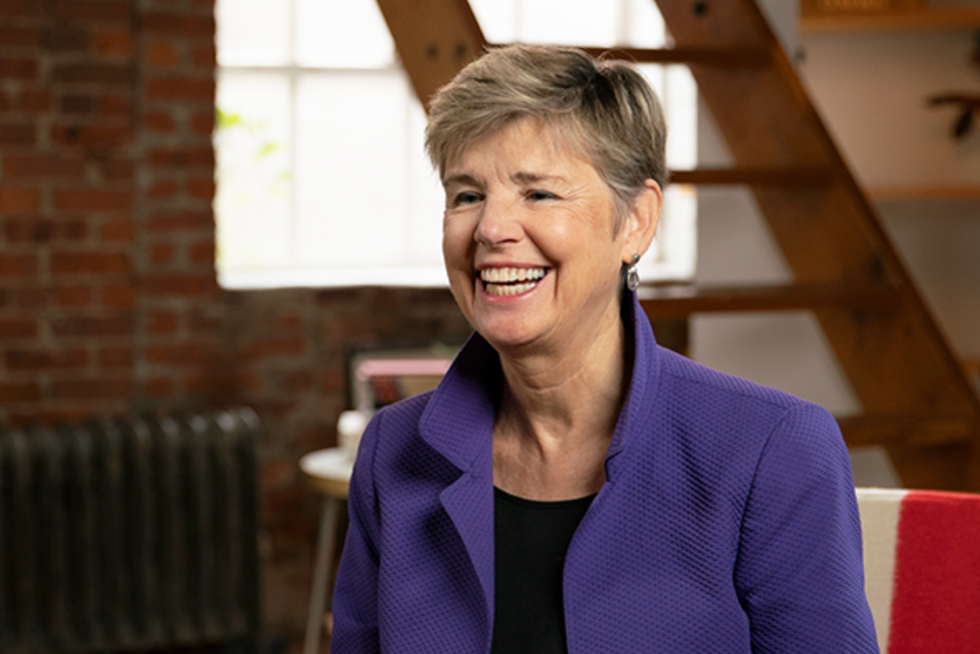Why bias training isn’t enough to increase workplace inclusivity
Feb 09, 2023
9 mins


Writer
Having a more gender-balanced workplace contributes to a company’s success. Not only does it positively impact employee well-being – research suggests it also increases profitability and productivity. But while companies have been rolling out diversity, equity, and inclusivity (DEI) initiatives for decades, the results are far from satisfying. To consider: men still occupy 65-95% of leadership roles globally. So what are companies doing wrong?
In her latest book, Rising Together: How We Can Bridge Divides and Create a More Inclusive Workplace, women’s leadership expert Sally Helgesen argues that our focus on biases have been largely unsuccessful in our quest for more inclusivity. To her, the way forward is a shift in mindset where the starting point isn’t how we think, but how we act. The result? A grounded, from-awareness-to-action guide to overcoming our difficulties in working across divides.
For the past 30 years, Helgesen has led workshops, conducted research, and written internationally best-selling books about the workplace with a focus on women and leadership. Her 2018 book How Women Rise, co-authored with leadership expert Marshall Goldsmith, examined the everyday habits that slow down women’s careers and gives tools to help them advance to the next level.
You’ve researched and written about women in leadership for decades. How have things changed since you started?
The most significant changes since I started writing about this topic in the late 80s are three:
- First of all, women have so much more confidence in their ability to contribute and their skills – which may not be the mainstream leadership skills defined in the 80s and 90s. They have more confidence in the value they bring in terms of relationships and their ability to notice different things. Women have had a significant impact on how organizations worldwide define excellence in leadership, and this has given them more confidence.
- Secondly, there is greater solidarity among women in the workplace. There’s still the so-called Queen Bee syndrome, where a woman gets into a position of influence and tries to keep other women out. In the 90s and early 2000s, I was recruited by companies to work with their women’s leadership initiatives, and they would struggle to get the senior women to support these efforts. They would say “I want to be seen here as a leader, not a woman.” This is different now. These initiatives seem to be viewed by many women as an opportunity for visibility and generally a career enhancer.
- Thirdly, women are much more aware of the need for allies and in particular male allies. They recognize that we can’t do this alone. And as we recruit people to help us, we have increasing confidence that we can also be of value to those people. The idea before was that a mentor was a kind of white night who would come along and rescue your career. It was a one-way relationship, and that has evolved into something that is much more reciprocal.
In your book How Women Rise, co-authored with leadership expert Marshall Goldsmith, you analyze the kinds of behaviors that hold women back. What are some of these behaviors?
By about 2014 I had been writing about women’s strengths for almost 25 years, and I realized that there were certain internal barriers that were fairly common and that it was time to write about them. These are not external barriers – cultural or structural – they are internal. The primary habits in that book are:
- Reluctance to claim your achievements or expect others to spontaneously notice and value your contribution. Women often fear that if they talk about themselves they’ll sound arrogant. We’re supposed to be focused on the team, so how can I talk about myself? There’s a barrier around making yourself visible and doing it in a way that is recognized and accepted. But it is incumbent upon women to find a way to do this because if they don’t they can end up feeling under-recognized, and over time this will cause them to become disengaged.
- Building rather than leveraging relationships. Women are often very skilled at building relationships and having a broad range of significant relationships with people at different levels. But they are often reluctant to engage their connections for either tactical (job-related) or strategic (career-related) requests. They feel that it will make them a “user.” Because women have often felt like they wouldn’t have anything to contribute, they have been reluctant to ask for help from someone more powerful, but it doesn’t have to be that way. You can view those requests as opportunities to pay the other person back in the future.
- Putting your job before your career: Pouring all your energy into the job you have now, rather than holding back 10% or 15% of that energy to think about where this it’s going to lead. It’s also important to do this in a way that is transparent and open. For example, telling people what you want to do next, asking what people think, what kind of skills you need, who you should meet, etc.
So the common theme is that women struggle, and to a certain extent are reluctant, to be noticed.
Yes, there’s a fear. And part of it is that women may have had pushback in their careers. I remember when I was younger I volunteered an idea in a meeting and my boss’s boss came up to me afterwards and said “well, you’re not afraid to share your opinions!” We often get that kind of pushback and then tell ourselves “I shouldn’t speak up,” “I don’t know how to do this.” These are the kinds of considerations that men rarely have. Men are rarely sitting in a meeting thinking “well, maybe somebody else has something more important to say so I’ll keep my mouth shut.” But people need to know who you are and get a sense of how you can contribute. Some people don’t want women to speak up, but that’s not your problem. And then it’s a question of just doing it over and over again so you get comfortable with it. How Women Rise encourages that sort of approach.
It can be very daunting to take these steps in a male-dominated environment. What can women do to not feel powerless in these situations?
Marshall has very interesting research that speaks to this point. He looked at organizations worldwide and asked: “What is the most common characteristic of people who are able to make long-term, positive behavioral change?” We’re talking about changing and shifting behaviors so that they will serve us better. He found that what they had in common was that they didn’t try to do it alone. They worked with a coach or they informally listed other people to help them and to help them. In How Women Rise I have a whole chapter on what I call “informal enlistment” which is a very successful technique. For example, you can go up to someone who has some degree of openness to you and ask them to support you in a meeting where you’ve been having a hard time speaking up. This is a flattering request for most people, and most of the time they will be happy to do it.
Your work has also shown that when women reach leadership positions, they can be very successful by approaching leadership in a completely different way to men. Can you talk about that?
This does not apply to all women, of course. But when I did the foundational research for my book The Female Advantage, I was trying to look at what very successful women leaders – who see being a woman as part of their leadership style – had in common. What I saw was that:
- They tend to build very strong relationships and they build them broadly, at a variety of levels in the organization, not just with other people at the top. They also communicated broadly as opposed to a chain of command. Because of this, they tended to put themselves in the center of things rather than at the top. Sometimes this was even literal: I went to women’s offices where they were actually at the center of the organization rather than isolated on the top floor, and they would say things like “I like to be where things are happening.”
- Because they had been outsiders, they also understood the value of outsider perspectives. As organizations around the world have become more diverse, this has only become an increasingly valuable and central leadership skill.
- They were comfortable bringing information or a leadership style from the home to the workplace and vice versa. They would bring home things they learned at the workplace rather than having a great gulf and separation between the two.
- And finally, I also noticed that women in leadership positions tend to have a big-picture view of the possibilities for the organization that is a little more all-encompassing. They will notice social or environmental impacts in their communities and that will help shape their vision of what is possible for the organization in the future.
You’ve also studied inclusivity more broadly in the workplace, and your new book is titled Rising Together: How We can Bridge Divides and Create a More Inclusive Workplace. How did the idea for this book come about?
It was a very specific incident. I was delivering a women’s leadership workshop at the Construction Super Conference in Las Vegas in 2019. I was expecting to talk to 150 women in the construction industry who felt frustrated because it was such a male-dominated industry. But when I got to the room, there were about 300 people and around 70% were men. I was so surprised and I realized that the talk I had prepared was not really apt for this group, so I asked them why they had come and they started talking about the difficulties they were having attracting – but especially retaining – women. Then one guy stood up and said “I hope you’re not going to waste your time telling us why being a better place for women and other outsiders is important. We understand, but we just don’t know how to do it. Can you tell us?” I realized I was not that prepared to answer that question but I thought, “there’s my next book.”
In the book you mention the “eight common triggers most likely to undermine our ability to collaborate.” What are they?
The idea of this book is building across the divide of gender but also age, race, ethnicity, sexual identity, etc. It looks at two things. First of all, it looks at what is most likely to undermine the efforts of organizations to do this. So I look at 8 common triggers that often get in the way of collaborating across divides: things like fairness, how humor is used, communication, visibility, etc. How these different approaches undermine and cement those divides. Then I look at how to address it, and this is very much focused on what I call ‘inclusive behavior.’ Part of the reason I wrote the book is that I wanted to help organizations shift their focus away from looking at bias, which has been the approach for the last 20 years. Usually, in a diversity initiative, the first thing you do is roll out unconscious bias training. But I wanted to help organizations shift away from that because there’s increasing evidence that it’s not that successful and it can also create a backlash. So I wanted to move the conversation towards inclusive behaviors: specific behaviors that people in a leadership position can practice, that you can encourage in the organization and that you can hold people to account for.
Can you explain the problem with focusing on bias in more detail?
What I realized about bias is that the emphasis is often on what people are really thinking, but people aren’t really impacted necessarily by what we’re thinking, they’re impacted by how we treat them, how we act, the words we use, etc. So to answer the question that I got in Las Vegas: the best way of doing this is for someone in a leadership position to give people benchmarks of how we need to behave. How to behave in meetings and performance reviews, the kinds of questions we’re going to ask, the ways we are going to evaluate people. Looking at how we behave can help organizations successfully retain a more diverse range of people, but also help them realize their full potential, which is what makes the organization successful.
What are, specifically, some of these inclusive behaviors?
All kinds of things. It can be something simple like pronouncing someone’s name properly. You still hear people pronouncing people’s names wrong after they’ve been there six months, and there have been studies of exit interviews where people said things like ‘my boss never learned how to say my name.’ Learn how to say someone’s name if it’s different, and don’t make a big deal out of it. It’s a tiny little thing, but it’s very common. Then there are things like including people in meetings and seating them in places where they actually participate. It’s very common to say “we’re going to let some of the younger people into this meeting” but then they’re all jammed in the back while everybody else is seated around a big table. It’s very hard to participate if you’re going to have to make your boss turn around to hear what you have to say. They’re simple things but they’re very common. I’ve got dozens of examples in the book. They’re small, inclusive behaviors that enable us to demonstrate our goodwill.
What do you think remains the biggest challenge for diversity in the workplace?
The biggest challenge is when the leadership is very unsupportive. Even though we have technologies that have distributed power and information more broadly, and even though there is a recognition that excellence in leadership is not about hoarding power and resources, and information, many organizations still have quite a hierarchical, bureaucratic structure. That structural barrier remains the biggest impediment to practicing these different kinds of behaviors because we can’t, as individuals, necessarily change that unless we’re in positions of significant influence and power. However, you can create your own little web where things work in a different sort of way. And one of the things that I’ve seen in my career is that when a company runs into issues they turn to people who are doing things differently as the next generation of leadership.
Photo: Sally Helgesen
Follow Welcome to the Jungle on Facebook, LinkedIn, and Instagram, and subscribe to our newsletter to get our latest articles every day!

More inspiration: DEI

Sh*t’s broken—Here’s how we fix work for good
Built by and for a narrow few, our workplace systems are in need of a revolution.
Dec 23, 2024

What Kamala Harris’s legacy means for the future of female leadership
The US presidential elections may not have yielded triumph, but can we still count a victory for women in leadership?
Nov 06, 2024

Leadership skills: Showing confidence at work without being labeled as arrogant
While confidence is crucial, women are frequently criticized for it, often being labeled as arrogant when they display assertiveness.
Oct 22, 2024

Pathways to success: Career resources for Indigenous job hunters
Your culture is your strength! Learn how to leverage your identity to stand out in the job market, while also building a career
Oct 14, 2024

Age does matter, at work and in the White House
What we've learned from the 2024 presidential elections about aging at work.
Sep 09, 2024
The newsletter that does the job
Want to keep up with the latest articles? Twice a week you can receive stories, jobs, and tips in your inbox.

Looking for your next job?
Over 200,000 people have found a job with Welcome to the Jungle.
Explore jobs